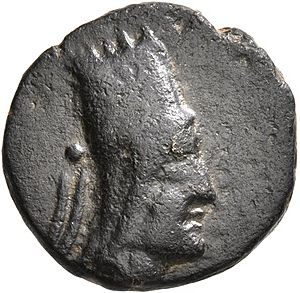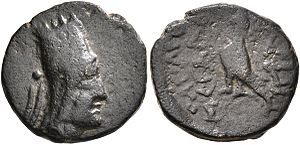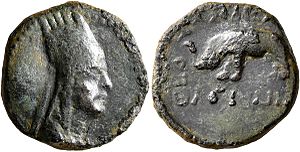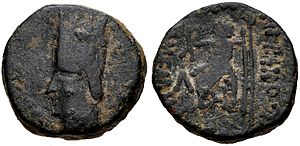Tigranes I facts for kids
Quick facts for kids Tigranes I |
|
|---|---|
| Great King | |

Coin of Tigranes I
|
|
| King of Armenia | |
| Reign | 120 – 95 BC (disputed) |
| Predecessor | Artavasdes I |
| Successor | Tigranes II the Great |
| Died | 95 BC |
| Issue | Two sons: Tigranes II Guras |
| House | Artaxiad |
| Father | Artaxias I |
| Mother | Satenik (?) |
Tigranes I of Armenia (Armenian: Տիգրան Ա, Ancient Greek: Τιγράνης) was a king of Armenia from the Artaxiad dynasty. He ruled around the end of the 2nd century BC and the beginning of the 1st century BC.
Not many records exist about his time as king or about his predecessor, Artavasdes I. This has caused some confusion among historians. Some experts even wonder if he was a real king. However, other historians like Manandian, Lang, and Adalian believe he was real. They just aren't sure about the exact dates he ruled. One idea is that Tigranes I ruled from 120 BC to 95 BC, and this has been supported by recent research.
Contents
The Name Tigranes
The name Tigránēs (Τιγράνης) is the Greek way of saying the Old Iranian name Tigrāna. In Armenian, it's Tigran (Տիգրան).
The exact meaning of the name is debated. It likely comes from an Old Iranian word meaning "slender." An Armenian historian named Movses Khorenatsi wrote about a "Tiran," who was the son of Artaxias and brother of Artavasdes. Many believe this "Tiran" was actually Tigranes I.
How Tigranes Became King
Tigranes I is thought to be the fourth of five sons of Artaxias I and Satenik. He became king because his older brother, Artavasdes I, didn't have a child to take over. Also, Artavasdes I had sent his other brothers away from the royal lands.
Tigranes I was made the Sparapet (a top army commander) for the western army by his father, King Artaxias I.
Later, one of Tigranes's brothers, Mazhan, tried to get King Artaxias to remove Tigranes and Artavasdes from their army roles. He wanted their roles given to another brother, Zariadres. King Artaxias said no. Mazhan then started planning against Tigranes. But Tigranes and Artavasdes found out about the plan. They ambushed and killed Mazhan during a hunting trip and buried him.
Battles and Alliances
Fighting the Seleucids
Around 165/4 BC, the Seleucid army, led by Antiochus IV Epiphanes, attacked Armenia. Tigranes's army was defeated, and he had to retreat. He waited for help from Artavasdes I and Smbat Bagratuni.
Eventually, the Armenian army defeated the Seleucid army. The Seleucids had to go back to Syria because of problems in their own country.
Dealing with Iberia
Three years later, Tigranes's brother, Zariadres, was captured after a battle. Tigranes, Artavasdes, and Smbat marched towards the area where Zariadres was held. They negotiated for Zariadres's freedom. They also made an alliance with the Iberian kingdom. In return, Armenia gave up some land.
Conflict with Parthia
After Artavasdes I was defeated by the Parthians, he was forced to give Tigranes's son, Tigranes II, as a hostage to Mithradates II. Armenia also had to accept that the Parthians had power over them.
Tigranes I's Time as King
Tigranes I became king in 120 BC after Artavasdes I died. Historians say that Tigranes I strongly resisted the Parthians. He successfully defended Armenia and faced no major conflicts after that.
He also removed the Vahevunis from their religious roles. He found out they had moved a gold statue of the god Vahagn from the city of Armavir to their own area after Artaxias I died.
According to the historian Khorenatsi, Tigranes owned two horses that were said to be faster than mythical winged horses. He also had a friendly rivalry with a prince named Datake, who bragged about being richer than the king.
Tigranes also had to deal with family land issues. Some of his relatives complained there wasn't enough land to divide among them. Tigranes told them to move to other regions. After seeing they couldn't split the land fairly, some of the Artaxiads moved.
Tigranes gave some of Artavasdes's former lands to a respected prince named Erakhnavu. Erakhnavu had married Artavasdes's last wife. Tigranes made him a high-ranking official and commander of the eastern army.
Tigranes also helped a Persian friend named Druasp, who had married into a noble family. Druasp was given a town and its lands, including vineyards. He set up his court in another town.
Tigranes married his daughter Eraneak to Trdat Bagratuni. Eraneak didn't like her husband and complained about his looks. This made Trdat angry, and he beat her badly. He then started a rebellion. However, he heard about Tigranes's death while on his way and ended the rebellion. Tigranes died in a snowstorm around 95 BC.
After Tigranes I died, his son Tigranes II returned from being a hostage with the Parthians. Tigranes II then became the new king. Modern research supports the idea that Tigranes II was the son of Tigranes I.
Overall, Tigranes I's time as king was mostly peaceful, except for the conflict with the Parthians.
Coins from Tigranes I's Reign

According to a coin expert named Kovacs, only three types of coins are believed to be from Tigranes I's reign. All of them have Greek writing that says "King Tigranes the Great." They show Tigranes I wearing a five-pointed tiara (a type of crown).
The back of these coins shows either:
- An eagle standing.
- A cornucopia (a symbol of plenty) with a grape cluster.
- A thunderbolt.

After Tigranes I died, his son Tigranes II declared him a god. Tigranes II then made coins with his father's image. These coins said "King Tigranes the Great and Divine." Six of these coins were made. Three were minted in Artaxata and three in Tigranocerta.
The back of these coins showed different images:

Some coin experts have suggested that certain coins showing a king without a beard are from Tigranes I. However, Kovacs believes these coins are actually from Tigranes II. This is because of the date on the coins and where they were made. These coins were minted in Nisibis, which Armenia did not control during Tigranes I's time.
Tigranes I's Family
Tigranes I had four brothers: Artavasdes I (who was king before him), Zariadres, Vruyr, and Mazhan. While Alan princess Satenik was the wife of Artaxias I, it's not certain if she was the mother of all these sons.
Tigranes I had two sons and one daughter:
- His successor, Tigranes II (who ruled from 95 to 55 BC).
- Guras, who was a governor of Nisibis. He was later captured by the Roman general Lucullus.
- Eraneak, who married Trdat Bagratuni.
According to a Roman writer, Tigranes II was born around 140 BC.
See also
 In Spanish: Tigranes I para niños
In Spanish: Tigranes I para niños


